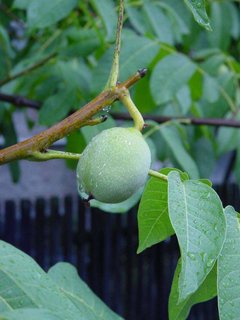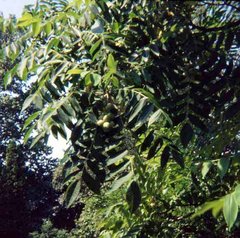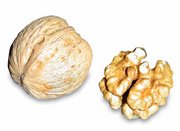From Wikipedia, the free encyclopedia.
| Walnut | ||||||||||||
|---|---|---|---|---|---|---|---|---|---|---|---|---|
 Shoot and nut of Juglans regia | ||||||||||||
| Scientific classification | ||||||||||||
| ||||||||||||
| Species | ||||||||||||
|
See text |
The walnuts (genus Juglans) are plants in the walnut family Juglandaceae. They are deciduous trees, 10-40m tall, with pinnate leaves 20-90cm long, with 5-25 leaflets; the shoots have chambered pith, a character shared with the wingnuts (Pterocarya) but not the hickories (Carya) in the same family.
The 21 species in the genus range across the north temperate Old World from southeast Europe east to Japan, and more widely in the New World from southeast Canada west to California and south to Argentina. The Latin name Juglans derives from Jovis glans, "Jupiter's nuts", the nut fit for a god; throughout recorded history the walnut has widely been regarded as the best nut of any.
Species and classification
- Sect.
Juglans. Leaves large (20-45 cm) with 5-9 broad leaflets, hairless,
margins entire. Wood hard. Southeast Europe to central Asia.
- Juglans regia L. (J. duclouxiana Dode, J. fallax Dode, J. orientis Dode) - Persian Walnut, Common Walnut
- Juglans sigillata Dode - Iron Walnut
- Sect.
Rhysocaryon. Leaves large (20-50 cm) with 11-23 slender leaflets, finely
pubescent, margins serrated. Wood hard. North
America, South America.
- Juglans australis Griseb. (J. boliviana Dode) - Argentine Walnut
- Juglans brasiliensis Dode - Brazilian Walnut
- Juglans californica S. Wats. - California Walnut
- Juglans hindsii (Jepson) R. E. Smith - Hinds' Walnut
- Juglans hirsuta Manning - Nuevo Leon Walnut
- Juglans jamaicensis C. DC. (J. insularis Griseb.) - West Indies Walnut
- Juglans
major (Torrey) Heller (J. arizonica Dode, J. elaeopyron Dode,
J. torreyi Dode) - Arizona Walnut
- Juglans major var. glabrata Manning
- Juglans
microcarpa Berlandier (J. rupestris Engelm.) - Texas walnut
- Juglans microcarpa var. stewartii (Johnston) Manning
- Juglans mollis Engelm. - Mexican Walnut
- Juglans neotropica Diels (J. honorei Dode) - Andean Walnut
- Juglans nigra L. - Black Walnut
- Juglans olanchana Standl. & L.O. Williams -
- Juglans peruviana Dode - Peruvian Walnut
- Juglans soratensis Manning -
- Juglans steyermarkii Manning - Guatemalan Walnut
- Juglans venezuelensis Manning - Venezuela Walnut
- Sect.
Cardiocaryon. Leaves very large (40-90 cm) with 11-19 broad leaflets,
softly downy, margins serrated. Wood soft. Northeast Asia, eastern North
America.
- Juglans ailantifolia Carr. (J. cordiformis Maxim., J. sieboldiana Maxim.) - Japanese Walnut or Heartnut
- Juglans cinerea L. - Butternut
- Juglans mandschurica Maxim. (J. cathayensis Dode, J. formosana Hayata, J. hopeiensis Dode, J. stenocarpa Maxim.) - Manchurian Walnut or Chinese Walnut

The best-known member of the genus is the Persian Walnut or Common Walnut (Juglans regia), native from the Balkans in southeast Europe, southwest & central Asia to the Himalaya and southwest China. This is the species which is widely cultivated for its delicious nuts. The Persian Walnut is often but incorrectly known as "English Walnut" in the United States (the species is not native to England).
The Black Walnut (Juglans nigra) is a common species in its native eastern North America, and is also widely cultivated elsewhere. The nuts are edible, but have a smaller kernel and an extremely tough shell, and they are not widely grown for nut production.
The Butternut or Butternut Walnut (Juglans cinerea) is also native to eastern North America, where it is currently endangered by an introduced disease, butternut canker, caused by the fungus Sirococcus clavigignenti. Its leaves are 40-60 cm long, and the nuts oval.
The Japanese Walnut (Juglans ailantifolia) is similar to Butternut, distinguished by the larger leaves up to 90 cm long, and round (not oval) nuts.
- Hybrids
- Juglans x bixbyi Rehd. - J. ailantifolia x J. cinerea
- Juglans x intermedia Carr. - J. nigra x J. regia
- Juglans x notha Rehd. - J. ailantifolia x J. regia
- Juglans x quadrangulata (Carr.) Rehd. - J. cinerea x J. regia
- Juglans x sinensis (D. C.) Rehd. - J. mandschurica x J. regia
- Juglans x paradox Burbank - J. hindsii x J. regia
- Juglans x royal Burbank - J. hindsii x J. nigra
Uses
- Nuts
The nuts of all the species are edible, but the walnuts commonly available in stores are from the Persian Walnut, the only species which has a large nut and thin shell. A horticultural form selected for thin nut shells and hardiness in temperate zones is sometimes known as the 'Carpathian' walnut. The nuts are rich in oil, and are widely eaten both fresh and in cookery. Walnuts are also an excellent source of omega-3 fatty acids, and have been shown as helpful in lowering cholesterol. They need to be kept dry and refrigerated to store well; in warm conditions they become rancid in a few weeks, particularly after shelling.
Walnut nut husks are often used to create a rich yellow-brown to dark brown dye that is used for dyeing fabric and for other purposes. When picking walnuts, the husks should be handled wearing rubber gloves, to avoid dyeing one's fingers.

